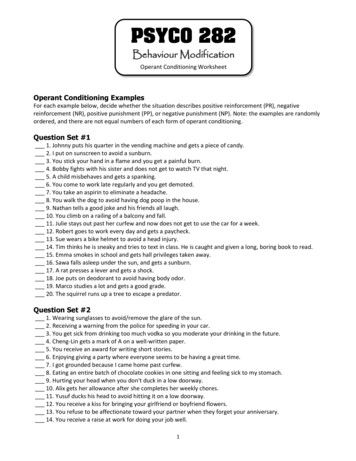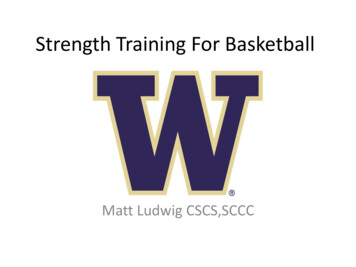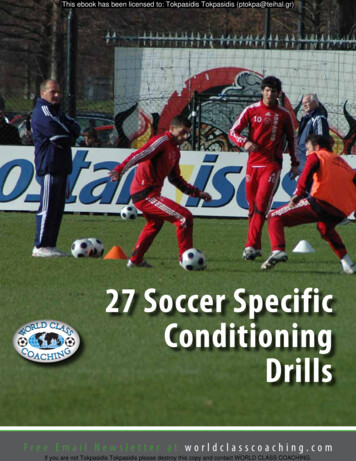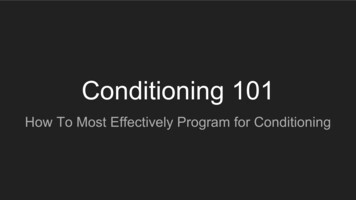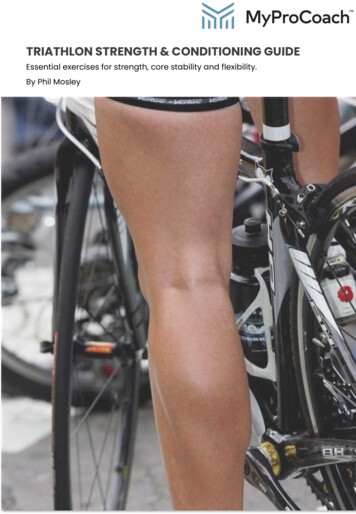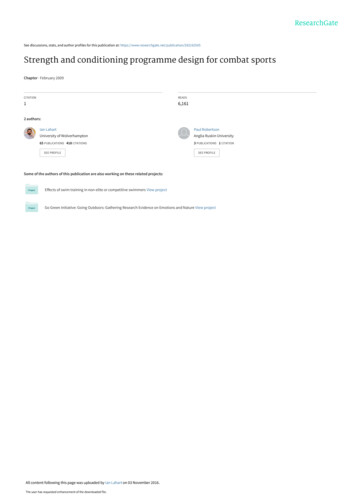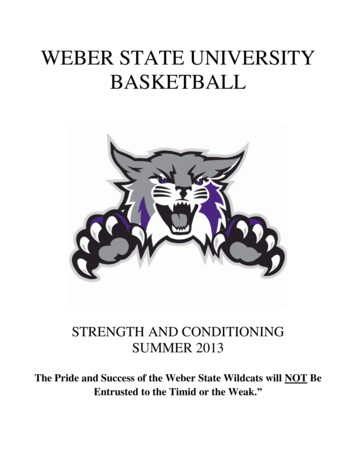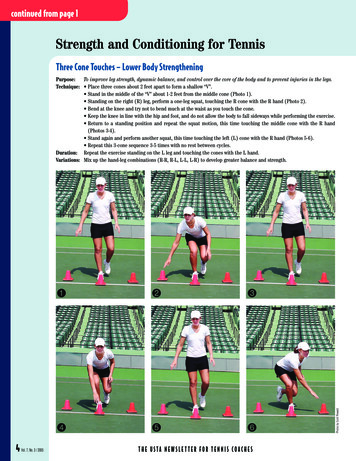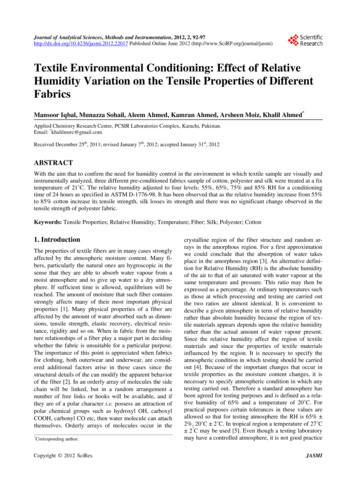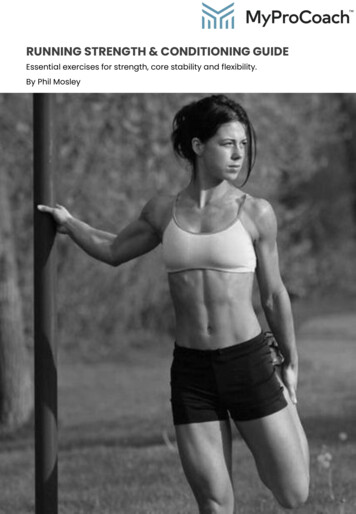
Transcription
RUNNING STRENGTH & CONDITIONING GUIDEEssential exercises for strength, core stability and flexibility.By Phil Mosley1
Strength and Conditioning for RunnersUsing This GuideYour training plan includes one or two strength sessions per week. Click each session to seewhich exercises you should do on a given day. You can refer to this PDF, if you need guidance.New to strength work, or unfamiliar with the exercises? We recommend booking a session ortwo with a personal trainer to check your technique and help you get the best from theworkouts.Exercise InstructionThis guide provides written descriptions of each exercise. Which muscles you are targeting and why. Aswell as tips, how to progress and alternatives. There are useful videos and images that show you whatyou need to do. You can adapt and progress sessions gradually according ability and experience.Click to view all the Strength and Conditioning Videos included in this PDF.(Save the playlist to your YouTube library for future reference).Why Do Strength And Conditioning?We have chosen specific strength and flexibility exercises to support your run training. They aredesigned to increase power, range of movement, coordination, flexibility, agility, strength and stabilityproviding you with a solid internal ‘scaffold’ to support all aspects of your training. You will improve yourefficiency and boost your performance.Injury PreventionIncluding strength and conditioning will help minimize the risks of injury through improved strength,stability and by matching imbalances that can be created by repetitive overuse.What Equipment Do I Need?All exercises (or alternatives) can be done at home with a mat, dumbbells and/or band. Or in the gymusing machines (where given as an alternative) and/or the free weights area.When Should I Do Strength Workouts?There are one or two strength workouts each week. If you have another workout scheduled on yourstrength day, you should run first. When switching things around in your calendar be conscious ofworkouts that follow your strength sessions.How Will Strength Sessions Fit With My Running Plan? Prep Phase: Develop neuromuscular efficiency, stability and functional strength. Base Phase: Build a foundation that can be used for power development. The goal is totranslate strength training into sport-specific activity. Build Phase: Develop power, balance and neuromuscular control. Form is key, reduce theintensity if you cannot hold your form. Peak Phase: Allows you to focus on sport-specific training. This means decreasing the stress ofa strength and conditioning training session by reducing intensity and volume.FlexibilityThere are six key flexibility exercises included. Select stretches that are specific to your requirements,the ones described within this document are a guide. You may have some favorites that work well for2you.
Strength and Conditioning for Runners1. SQUATWorks: Glutes, hamstrings and quads.Why: Generates strength, power and stability.1.Stand with your feet shoulder-width apart and pointing straight ahead, arms at your sides.2.Initiating the move with your hips, squat back and down until your thighs are parallel to thefloor.3.Return to a standing position by pushing through your hips.Tips: Keep your chest up, back flat, and do not let your knees collapse to the inside.Progressions: Add weights, squat jumps.Alternatives: Smith machine, leg press machine, goblet squat.2. SQUAT JUMPWorks: Glutes, hamstrings and quads.Why: Boosts explosive power.1.Stand with feet just outside of shoulders.2.Sit back and down into squat position, keeping knees behind toes.3.Immediately jump vertically by extending through hips and swinging arms for propulsion.4.Land softly in squat position with hips back and down. Immediately repeat the samemovement.Tips: Keep chest up during the jump. Extend hips completely during jump.Progressions: Increase reps, reduce rests.Alternatives: Any low impact weighted squat variations, leg press, box jumps.3
Strength and Conditioning for Runners3. SINGLE LEG SQUATWorks: Glutes, hips, hamstrings, calves and quads.Why: Strengthen your force producing muscles to promote power, strength and stability.1.Stand on one foot with your other leg bent at the knee.2.Once you’re balanced on one leg, squat down as low as you can without losing your form (ortoppling over). Don’t let your standing knee go past the front of your toes while you squat.3.Pause at the bottom of the squat for a second, then push back up through your heel,squeezing your glutes as you go.Tips: Hold both arms out in front of you during the exercise to help keep your balance.Progression: Hold raised leg straight out in front (pistol squat), increase reps.Alternatives: Bulgarian squat, alternate lunges.4. BULGARIAN SQUATWorks: Glutes, hamstrings and quads.Why: Strength, balance and core control.1.Find yourself anything stable that you can rest a foot on, it needs to be about knee height.2.Get into a forward lunge position with torso upright, core braced and hips square to yourbody, with your back foot elevated on bench. Your leading leg should be about half a metrein front.3.Lower until your front thigh is almost horizontal, keeping your knee in line with your foot.4.Drive up through your front heel back to the starting position, keep your movementsmeasured. Repeat your reps on one leg before switching sides.Tips: Don't let your front knee travel beyond your toes. Keep your torso upright.Progressions: Add weight, increase reps, reduce rest.Alternatives: Single leg squat, pistol squat, single leg press.4
Strength and Conditioning for Runners5. ALTERNATE LUNGEWorks: Glutes and quads.Why: Increase strength, power, range of movement and stability.1.Start with your feet about shoulder width apart, standing tall with your core engaged.2.Step forward into lunge and lower until you reach approx. 90 degrees at both knees.3.Push your body back up to the starting position through your front heel, switch legs andrepeat. 1x right and 1x left is one rep.Tips: Don’t extend the front knee past your toes. Keep your torso upright.Progression: Add weight, increase reps, reduce rest, make this exercise dynamic by adding jumpswitch.Alternatives: Squats, leg press, step ups, reverse lunges6. REVERSE LUNGEWorks: Glutes, hamstrings, calves and quads.Why: Driving back to the starting position mimics the running movement.1.Stand upright, core tight.2.Take a big step backwards with your left foot and lower until both knees are at 90 degrees.3.Push back up and return to starting position. Repeat with right leg. This is one rep.Tips: Keep your torso upright and focus to stay balanced.Progression: Add weight, increase reps, reduce rest.Alternatives: Alternate lunges, step ups, squats, leg press.5
Strength and Conditioning for Runners7. STEP UPWorks: Quads and hamstrings.Why: Build leg strength, power, flexibility and cardiovascular abilities.1.Stand facing the step or box.2.Place right foot on the step and stand up onto the step by extending the hip and knee of theraised right leg. Place both feet onto the platform.3.Step back down with the left leg. Switch sides and repeat with left leg leading. This is one rep.Tips: Keep your chest up throughout the movement.Progression: Add weight (dumbbells, weight vest or barbell), heighten step, add power by adding ahop as you step up.Alternatives: Alternate lunges, reverse lunges.8. CALF RAISEWorks: Calves.Why: Improve strength and stability, power the push off in running and prevent injury.1.Stand tall, core engaged.2.Push through the balls of your feet and raise your heel until you are standing on your toes.3.Slowly lower to return to your starting position.Tips: Don’t rush!Progression: Add weight (hold dumbbells), perform on a step to enable you to drop the heel lower.Alternative: Farmer’s walk on toes (walk holding dumbbells on toes).6
Strength and Conditioning for Runners9. HIGH KNEESWorks: Cardio, glutes, hamstrings and quads.Why: A cardio exercise that improves power, stability, flexibility and running form.1.Begin standing tall, core engaged and ready to jog in place.2.Flex the hip and bring your right knee towards your belly button, aim for your thigh to beparallel with the floor. As the right leg comes down lift the left knee. Ix right plus 1x left is 1 rep.Tips: Pump your arms. Stay dynamic and strong throughout. Keep your knees high.Progression: Increase duration.Alternatives: Step up with hop, skipping with rope, jump squats.10. BOX JUMPWorks: Quads, calves and hamstrings.Why: Explosive lower body power for strength and speed.1.Stand in front of the box with feet directly under the hips, hands by your side.2.Bend your knees and hips. Explosively jump up from the crouched position, swing your armsto help.3.Land softly on the center of the box, absorbing impact with your legs.4.Stand tall. Jump or step back to the starting position. Repeat.Tips: When starting out choose a low box or step, stop when your form and speed arecompromised.Progression: Use a higher box/platform.Alternatives: Squat jumps, step ups.7
Strength and Conditioning for Runners11. LATERAL AND FRONT RAISE COMBOWorks: Deltoids.Why: Strengthen shoulders and upper body to power your arm drive.1.Stand with your feet hip-width apart and hold core tight. Hold dumbbells in each handpalms facing each other.2.Raise dumbbells to sides until arms are parallel to ground, lower to start position.3.Turn hands so palms face back, raise dumbbells in front until arms are parallel to floor,lower to start position.4.1x lat and 1x front raise is one rep. Repeat.Tips: Keep your core tight and elbows soft, don’t swing the weights, stay in control.Progression: Increase weights, increase reps, reduce rest.Alternatives: Using an exercise band, cable machine, lat raise machine.12. BENT OVER ROWWorks: Lats, rhomboids, scapular stabilizers, shoulders, biceps, spinal erectors, glutes andhamstrings.Why: Strengthens back and core stabilizers for postural endurance on your long runs.1.Bend knees slightly and hinge at the hip keeping your back straight. Hold bar or dumbbells(palms facing back).2.Keep upper body stationary and pull weights to the torso and pause.3.Return to starting position controlling the movement throughout.Tips: Hold core tight throughout.Progression: Increase weight.Alternatives: Use band, lat pulldown, seated rows, inverted rows.8
Strength and Conditioning for Runners13. PUSH UPWorks: Pectorals, shoulders, triceps and core.Why: Upper body strength to power your arms for the run.1.Lie face down on floor, hands slightly wider than shoulder width.2.Push down on the floor with your hands and raise the body up be extending the arms.Maintain a straight line from your heels, through hips, shoulders and back of head.3.Lower body back down to the floor be bending the arms. Repeat.Tips: You can do this from your knees, in a ¾ position. Don’t lock out your elbows.Progression: Increase reps, add weight (vest or plate).Alternatives: Incline dumbbell bench press, flyes.14. BENCH PRESSWorks: Pectorals, shoulders and triceps.Why: Increase upper body strength and add power to your arm drive.1.Lie back on bench, grasp bar (or dumbbells) with overhand grip slightly wider than shoulderwidth.2.Dismount bar from rack and lower to the middle of your chest.3.Press the bar back up until arms fully extended then lower bar back down to to chest.Tips: Remain in control and focus on the chest muscles you are targeting. Raise the knees placingankles on foot rests if your back arches.Progression: Increase weight.Alternatives: Push ups, flyes, incline dumbbell bench press.9
Strength and Conditioning for Runners15. TRICEP KICKBACKWorks: Triceps.Why: Strength for a powerful arm drive.1.Kneel one leg on bench or chair, other foot flat on floor, bend forward 45 degrees from hip.2.Hold weight in opposite hand to supporting knee and keep your upper arm parallel to floor,tight to side with a 90-degree bend at the elbow.3.Raise your lower arm out behind you so that the arm with weight is straight out behind you.4.Under control lower back to starting position. Repeat. When full number of reps is done repeaton opposite side.Tips: Keep the upper arm strong and still throughout the movement. Hold core tight and stay incontrol.Progressions: Increase weight.Alternative: Tricep dips, cable triceps pushdown.16. TRICEP DIPWorks: Triceps, chest and anterior shoulders.Why: Strength for a powerful arm drive.1.Position your hands, shoulder width apart on stable bench or chair.2.Slide off the chair with your legs slightly bent extended in front of you with your arms straight.3.Lower towards the floor until 90-degree bend at elbow, keep the elbows pointed back.4.Slowly push up back to the starting position. Repeat.Tips: Focus on powering up using the muscles at the back of your arm, avoid collapsing downwards.Progression: Straighten your legs for increased intensity.Alternatives: Tricep extensions, overhead tricep extension with dumbbell or band.10
Strength and Conditioning for Runners17. GLUTE BRIDGEWorks: Glutes, hamstrings, erector spinae, rectus abdominis and adductors.Why: Increase power for running and flexibility through the hips. Injury prevention.1.Lie face up on the floor, knees bent and feet flat on the ground, shoulder width apart.2.Lift your hips off the ground until your knees, hips and shoulders form a straight line. Squeezeyour glutes hard and keep abs tight.3.Hold the bridge for a couple of seconds before easing back down.Tips: Take care not to over extend and arch the back. Focus on squeezing the glutes, don’t rush.Progression: Advance to single leg bridge with one leg raised and stretched out straight.Alternatives: Squats, donkey kicks, standing glute kicks with band, glute machine, adductormachine.18. BIRD DOGWorks: Core strengthening.Why: To improve your ability to stabilize your core whilst mobilizing your extremities.1.Begin on all fours, hands under shoulders and knees under hips. Tighten and hold your core.2.Reach opposite arm forward and leg back so that they are straight. Reach through left heelto engage hamstrings and glutes.3.Return to a starting position and repeat on other side. That is one rep.Tips: Hold pelvis stable throughout. Take care not to lift arm/leg above parallel. Keep shouldersaway from the ear.Progressions: Increase reps, add a crunch by bringing elbow and knee together under you.Alternative: Plank with leg lift.11
Strength and Conditioning for Runners19. LYING HIP ABDUCTIONWorks: Glutes, hamstrings, TFL and hip abductors.Why: Stability and injury prevention.1.Lie on your side on a mat with your legs extended away from the body.2.Your lower arm placed under your head. Raise the top leg keeping the foot in a neutralposition and the hips vertical to the floor. Raise the leg to about 45 degrees.3.Slowly lower to your starting position. Repeat.Tips: Any higher than 45 degrees and the movement involves the entire hip detracting from thetarget muscles.Progression: Add ankle weight or band and/or reps.Alternative: You can do this standing with a band or ankle weight, clamshells, adduction machine.20. PLANKWorks: Abdominals and back.Why: Core stability.1.Face down resting your weight on your forearms and toes, pull your abs in tight.2.Maintain a hold for as long as you can with your body is in a straight line from shoulders toheels.Tips: Don’t allow your hips to sag or back to arch up. When your form slips take a rest. Keepelbows in line with shoulders.Progression: Increase hold time, alternating leg raises (hold leg up for 10-20 seconds beforeswitching).Alternatives: Mountain Climbers, bird dog.12
Strength and Conditioning for Runners21. SIDE PLANKWorks: Abdominals and shoulders.Why: Promotes core strength by targeting obliques, hips and upper body.1.Lie on your side with your right forearm resting on the ground, feet on top of one another.2.Lift your body off the ground supported by your forearm and feet, into side plank position.Attain straight line through shoulder hips and ankles.3.Hold for requisite time.Tips: Maintain form and don’t allow lower hip to drop.Progression: Separate the legs and raise top leg into the air forming a star shape.Alternatives: Spider Climber, bicycle crunches.22. MOUNTAIN CLIMBERWorks: Cardio, abdominals, deltoids, biceps, triceps, chest, quads, hamstrings and hip abductors.Why: Work multiple muscle groups improving mobility and strength.1.Start in a push up position with straight arms, a flat body, your abs tight and your weightover your hands.2.Pull your right knee into your chest holding the plank position. Switch and pull the left knee inwhilst pushing your right leg back. This is 1 rep.Tips: Stay strong throughout. Keep body flat.Progression: Make dynamic by adding jump switch. Increase reps/time.Alternative: Bicycle crunch, plank with leg raise, high knees, ab machine.13
Strength and Conditioning for Runners23. SPIDER CLIMBERWorks: Abdominals, obliques, deltoids, biceps, triceps, chest, quads, hamstrings and hip abductors.Why: Work multiple muscle groups improving mobility and strength.1.Start in a plank position on elbows, a flat body and your abs tight.2.Bring your right knee to the outside of your right elbow, alternate each side.3.1x right plus 1x left is 1 rep.Tips: Stay strong throughout, cease when you cannot hold form.Progression: Increase reps/time. Come up onto hands and add a jump switch to make this moredynamic.Alternative: Bicycle crunch, plank.24. BICYCLE CRUNCHWorks: Abdominals.Why: Improve structural core strength to maintain form and prevent injury.1.Lie flat on your back, knees bent, finger tips at temples.2.Engage your core and raise your knees so your thighs are vertical with the floor.3.Drive your right knee towards your chest at the same time extend your left leg towards themat.4.Crunch until your right knee touches your left elbow then switch sides.Tips: Stay strong, stable and in control of the movement throughout. Cease if your form slips.Progression: Increase reps.Alternative: Spider Climbers, plank, sit-ups.14
Strength and Conditioning for Runners25. SIT UPWorks: Abdominals, hip flexors.Why: Improve your structural core strength.1.Lie on the floor with your knees bent. Optional, tuck your feet under something for stability(or have partner hold your feet). Have your fingertips at your temples, or crossed on chest.2.Lift your upper body off the floor and towards your thighs. Contract your abs.3.Lower back to the starting position. This is 1 rep.Tips: Stay in control throughout, keep your elbows back and don’t pull on the head/neck.Progression: Have plate on chest to add resistance.Alternatives: Plank, bicycle crunches, ab machine.26. REVERSE CRUNCHWorks: Abdominals.Why: Core strength.1.Lie face up on the ground with hips bent at 90 degrees, legs relaxed.2.Pull your knees towards your chest by tilting your pelvis until your tailbone lifts off the ground.3.Lower back down without letting your feet touch the ground. Stay in control throughout.Tips: Don’t let your back arch, if it helps you can tuck your hands under your backside.Progression: Increase reps/sets, place hands at temple and hold head & shoulders off the groundwhilst crunching.Alternatives: Mountain climber, sit-ups, bicycle crunches, ab machine.15
Flexibility for Runners1. FLEXIBILITY: DOWNWARD DOGStretches: Back, hips, hamstrings and calves.Why: Uses strength of arms and legs to fully and evenly stretch your spine.1.Start on floor on hands and knees. Set knees directly below your hips and hands slightlyin front of shoulders. Palms spread. Turn toes under.2.Breathe out and lift knees away from floor. To start keep knees slightly bent and heelslifted.3.Lift sitting bones towards the ceiling. Gently pedal your heels towards the ground andstraighten your legs.4.Hold from 1-3 minutes.2. FLEXIBILITY: PIGEON POSEStretches: IT Band, glutes and hip flexors.Why: Injury prevention and hip mobility1.Start on hands and knees, bring your right knee forward and close to your right wrist, anklenear left hip.2.Slide your left leg back, straighten knee and point toes, heel to ceiling.3.You can stay here with your upper body upright or exhale and fold forwards over the frontleg.4.Stay relaxed and hold pose for 30-40 seconds. Switch sides. Repeat as required.16
Flexibility for Runners3. FLEXIBILITY: HIP FLEXOR STRETCHStretches: Hip flexors, glutes and quads.Why: Keeping your hips open allows you to maximize your strength in full range of movement.1.2.3.From kneeling with left knee directly under hip place the right foot in front of right hip.Rest hands on knee or down to ground, wherever you feel is right for you.Hold for 20-30 seconds before switching sides. If you are tight repeat on both sides.4. FLEXIBILITY: FIGURE 4 STRETCHStretches: Glutes and piriformis.Why: Mobilize hip joint, ease stiffness in the back.1.Lie flat on the floor. Bend one knee and place opposite ankle on thigh of bent leg. Hold thebent leg with clasped hands behind the thigh and ease it to your chest.2.Hold for 20-30 seconds. Release and repeat on opposite side.3.Repeat as required.17
Flexibility for Runners5. FLEXIBILITY: HAMSTRINGStretches: Hamstrings.Why: Lets blood flow back whilst stretching your hamstrings. Tight hamstrings can lead topressure on the lower back and restricted hip flexibility and range of motion.1.2.3.Lie on the ground by open door, back flat and resting leg out flat.Slide the foot of the stretching leg up the wall until straight.Keep your back neutral and relax. Hold for 30–40 seconds, switch legs.6. FLEXIBILITY: CHEST OPENERStretches: Chest.Why: Opens out the chest and improves posture.1.Stand, feet hip width. Clasp your hands behind your back (or hold towel).2.Squeeze your shoulder blades together.3.Hold for 20-30 seconds, rest and repeat as required.18
Alternatives: Use band, lat pulldown, seated rows, inverted rows. Works: Deltoids. Why: Strengthen shoulders and upper body to power your arm drive. 1. Stand with your feet hip-width apart and hold core tight. Hold dumbbells in each hand palms facing each other. 2. Raise dumbbells to sides until arms are parallel to ground, lower to start .
